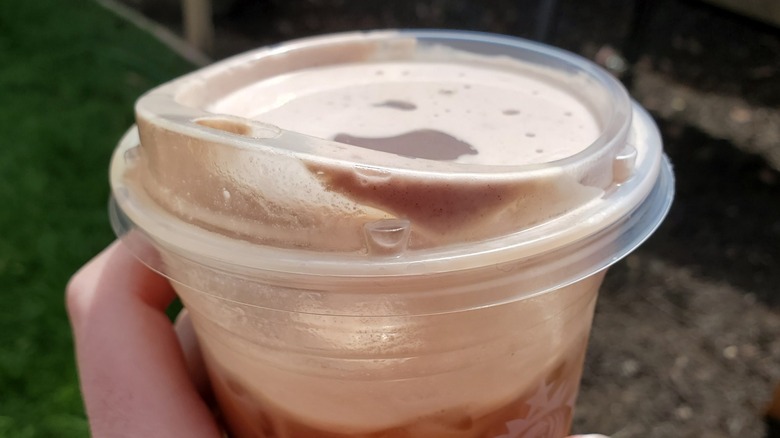The Flavor Difference Between Starbucks' Iced Coffee And Cold Brew
Cold coffee used to mean something you abandoned, requiring a spin in the microwave for revival. Then iced coffee became a thing, followed by the newer caffeine kid in town: cold brew. Starbucks devotees know it well, despite cold brew's origins in Japan, not Seattle. It reportedly sprang from the concept of Kyoto-style coffee, which dates back to the 1600s, in which coffee slowly steeps or drips through cold water. Starbucks goes the steeping route, bringing out nuanced flavors that are very distinct from those of iced coffee.
The flavor difference between Starbucks' Iced Coffee and Cold Brew starts with the brewing method. Iced coffee comes from hot-brewed coffee that's later cooled down and diluted with water. A baseline standard for Starbucks Iced Coffee is a double-strength measurement of 4 tablespoons of coffee to 6 ounces of water, keeping in mind that added ice naturally weakens the strength, and therefore the taste, even more. Though typically medium-bodied and balanced with notes of cola and caramel, you can also make iced coffee bolder and more intense by using a higher water-to-coffee ratio or choosing dark roasted beans.
Cold brew coffee, on the other hand, lets time and cool temperature do the brewing, sans the heat. Starbucks describes its process as cold-steeping coarse-ground coffee beans in cool water, filtered for a pure taste, and letting it sit for at least 12 and up to 24 hours. The essence of the beans gets extracted very slowly when making cold brew, resulting in a more full-bodied drink with smoother flavors, lower acidity, notes of chocolate, and extra natural sweetness. Still, if you're wondering what to order when Starbucks runs out of its small batch Cold Brew, an Iced Coffee works in a pinch.
Creative concoctions with cold brew and iced coffee
Pretty much anything goes when putting creative spins on cold coffee drinks, both in iced and cold brew forms. But the core component can be more, or less, compatible with other added ingredients. For example, in its simplest form, a tall frosty glass of iced coffee morphs into a super sweet treat with a splash of cream, raw granulated sugar, or any number of flavored syrups. Cold brew fans instead lean toward savoring the subtle, smooth coffee flavor nuances on their own, sipping them black with extra ice. There are also plenty of Starbucks cold foams to choose from, all of which make great Cold Brew toppers.
Starbucks does, however, suggest some cold coffee variations based on the overall features of each type. The flavors of double-brewed Starbucks Breakfast Blend iced coffee mix well with cinnamon and sweetened condensed milk, shaken in a cocktail shaker and served with ice. For a grown-up drink, cold brew coffee offers a twist on a classic old fashioned. There's no whiskey involved in a Starbucks Cold Brew Old Fashioned, just Angostura bitters, Cold Brew coffee, orange syrup, and garnishes of orange peel and cocktail-style cherries.
With either cold coffee brewing method, your own masterpiece drink awaits. Try things like adding rich coconut milk, incorporating various spices and herbs, or substituting tonic water or chocolate milk for the plain water. Types of iced coffee abound, and many can be transformed with your own blends, strengths, and tweaks on iced or cold brew coffee. Try making a dark roast Vietnamese iced coffee, a Greek-style frothy frappé, or an Aussie iced coffee with vanilla ice cream.

